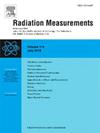从标准化x射线束中测量的空气克尔玛校准系数的实验值推导电离室响应曲线的方法
IF 2.2
3区 物理与天体物理
Q2 NUCLEAR SCIENCE & TECHNOLOGY
引用次数: 0
摘要
空气当量电离室是剂量学校正实验室测量空气温度的参考仪器。给定电离室响应的能量依赖性通常以其空气克尔玛校准系数NK,a的离散值集为特征,该值以标准化光子光束测量。对于能量低于300 keV的光子,最常用的标准化校准光束是x射线光束,即具有连续光谱的光束。给定电离室的能量依赖性可以用响应函数fIK(E)来描述,该函数描述了在恒定空气克马赫速率下,电离室的电响应大小对光子能量E的依赖性。在实践中,这种表征电离室响应的能量依赖性的方法很少使用,因为覆盖上述能量范围的单能校准光子束通常不可用,因此很难通过实验测量响应函数fIK(E)。在这项工作中,我们表明:a)给定电离室的响应函数fIK(E)可以从标准化x射线校准光束中测量的空气克尔玛校准系数NK,a的值推导出来;b)所提出的方法可以揭示空气克尔玛校准系数NK,a的集合中可能存在的内部不一致性;c)给定电离室的响应函数fIK(E),由一组电离室的NK得到,一个值可以用来预测电离室的NK,一个值可以用来预测电离室的其他x射线束。本文章由计算机程序翻译,如有差异,请以英文原文为准。
Method of deriving the response curve of an ionisation chamber from experimental values of its air kerma calibration coefficients measured in standardised X-ray beams
Air-equivalent ionisation chambers are the reference instruments for measuring air kerma in dosimetry calibration laboratories. The energy dependence of the response of a given ionisation chamber is usually characterised by a discrete set of values of its air kerma calibration coefficients, NK,a, measured in standardised photon beams. For photon energies below 300 keV, the most commonly used standardised calibration beams are the X-ray beams, i.e. beams with continuous spectra.
The energy dependence of a given ionisation chamber could alternatively be characterised by the response function fIK(E) which describes the dependence of the magnitude of the electrical response of the chamber on the photon energy, E, at a constant air kerma rate. In practice, this method of characterising the energy dependence of the ionisation chamber response is rarely used because monoenergetic calibration photon beams covering the above mentioned energy range are not routinely available and it is therefore difficult to measure the response function fIK(E) experimentally.
In this work, we show that:
a) the response function fIK(E) of a given ionisation chamber can be derived from the values of its air kerma calibration coefficients, NK,a, measured in standardised X-ray calibration beams;
b) the proposed method can reveal possible internal inconsistencies in the set of air kerma calibration coefficients, NK,a, of an ionisation chamber;
c) the response function fIK(E) of a given ionisation chamber derived from a set of its NK,a values can be used to predict the NK,a values of the chamber for other X-ray beams.
求助全文
通过发布文献求助,成功后即可免费获取论文全文。
去求助
来源期刊

Radiation Measurements
工程技术-核科学技术
CiteScore
4.10
自引率
20.00%
发文量
116
审稿时长
48 days
期刊介绍:
The journal seeks to publish papers that present advances in the following areas: spontaneous and stimulated luminescence (including scintillating materials, thermoluminescence, and optically stimulated luminescence); electron spin resonance of natural and synthetic materials; the physics, design and performance of radiation measurements (including computational modelling such as electronic transport simulations); the novel basic aspects of radiation measurement in medical physics. Studies of energy-transfer phenomena, track physics and microdosimetry are also of interest to the journal.
Applications relevant to the journal, particularly where they present novel detection techniques, novel analytical approaches or novel materials, include: personal dosimetry (including dosimetric quantities, active/electronic and passive monitoring techniques for photon, neutron and charged-particle exposures); environmental dosimetry (including methodological advances and predictive models related to radon, but generally excluding local survey results of radon where the main aim is to establish the radiation risk to populations); cosmic and high-energy radiation measurements (including dosimetry, space radiation effects, and single event upsets); dosimetry-based archaeological and Quaternary dating; dosimetry-based approaches to thermochronometry; accident and retrospective dosimetry (including activation detectors), and dosimetry and measurements related to medical applications.
 求助内容:
求助内容: 应助结果提醒方式:
应助结果提醒方式:


